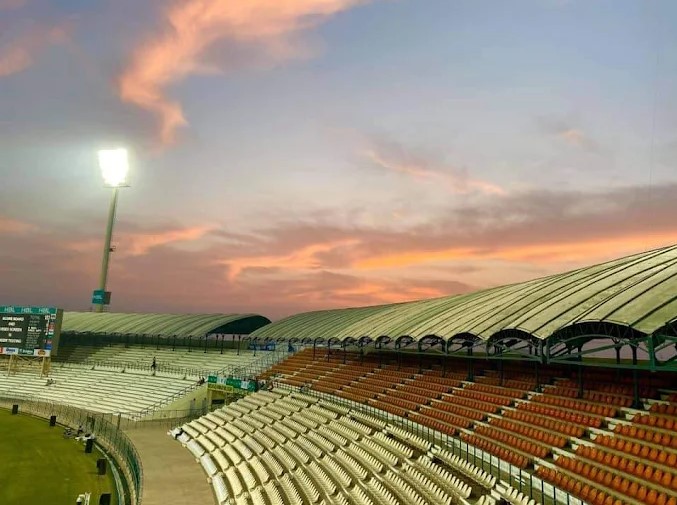Multan Cricket Stadium, located in the southern region of Punjab, Pakistan, is one of the country’s premier cricketing venues. While fans often focus on the pitch conditions, team compositions, or player performances, one crucial and often overlooked element is the boundary length of a stadium. The size and structure of the boundaries can significantly influence scoring patterns, bowling strategies, and even match outcomes.
Table of Contents
In this article, we’ll explore the detailed boundary specifications of Multan Cricket Stadium, how it compares to other stadiums around the world, and what implications these dimensions have on modern cricket.
Overview of Multan Cricket Stadium
| Feature | Details |
|---|---|
| Location | Multan, Punjab, Pakistan |
| Year Opened | 2001 |
| Seating Capacity | Approximately 30,000 |
| Ends | Pavilion End & North Pavilion End |
| Home Team | Multan Sultans (PSL) |
| Hosted Formats | Test, ODI, T20I, PSL |
Official Boundary Measurements
Boundary distances at Multan Cricket Stadium conform to ICC regulations, but they can vary slightly depending on the pitch position and ground setup on the day of the match.
| Direction | Approximate Length (in meters) | Notes |
|---|---|---|
| Straight | 70 – 74 m | Standard international length |
| Square | 65 – 67 m | Slightly shorter, ideal for cuts/pulls |
| Fine Leg | 62 – 64 m | Often targeted in reverse sweeps |
| Third Man | 61 – 63 m | Common spot for innovative shots |
| Long-On/Long-Off | 73 – 75 m | Longer, requires timing and power |
On average, the boundaries at Multan range between 61 to 75 meters, depending on the specific side of the wicket and the match format. These dimensions align with international standards, where the minimum boundary size must be 59.43 meters (65 yards) from the center of the pitch.
Why Boundary Length Matters
You might wonder, “Why does a few meters more or less make a difference?” In elite-level cricket, even marginal changes in ground size can influence:
- Batting Approach: Batsmen adjust shot selection based on boundary distances.
- Bowling Strategy: Bowlers tweak their lengths to either entice big shots or force mis-hits.
- Field Placement: Captains may deploy fielders closer to or deeper on the boundary depending on the side’s vulnerability.
How Multan Compares with Other Grounds
To understand the uniqueness of Multan Cricket Stadium, let’s compare its boundary measurements to those of well-known stadiums around the world:
| Stadium | Country | Shortest Boundary | Longest Boundary |
|---|---|---|---|
| Multan Cricket Stadium | Pakistan | 61 m | 75 m |
| Eden Gardens | India | 65 m | 74 m |
| MCG (Melbourne) | Australia | 65 m | 85 m |
| Sharjah Cricket Stadium | UAE | 58 m | 65 m |
| Lord’s Cricket Ground | England | 59 m | 70 m |
| Gaddafi Stadium (Lahore) | Pakistan | 62 m | 74 m |
Match Impact: Format-Specific Analysis
Test Matches
In longer formats like Tests, boundary length plays a slightly subdued role. With batsmen prioritizing technique and accumulation over aggression, fewer balls are hit directly to the boundary. However, on days four and five, when scoring quickly becomes critical, shorter square boundaries often become target zones.
ODIs
In ODIs, the middle overs typically witness spinners bowling into the wind or towards longer boundaries, forcing batsmen to take risks. This is where bowlers use boundary knowledge as a strategic advantage.
T20s
T20s are where boundary sizes matter the most. Batsmen with power-hitting capabilities look to exploit the shorter regions. In Multan, square leg and third-man areas (approx. 61–64 meters) are frequently targeted in death overs.
Real-World Scenarios at Multan
Let’s examine a few real match situations to understand the relevance of boundary lengths:
| Match | Format | Boundary Factor | Outcome |
|---|---|---|---|
| Pakistan vs. West Indies (2022) | ODI | Short square boundaries | Babar Azam scored freely on offside |
| Multan Sultans vs. Lahore Qalandars (PSL 2023) | T20 | Long straight boundary | Bowlers used length to force catches |
| Pakistan vs. England (2022) | Test | Balanced boundaries | Seamers bowled wide outside off-stump |
Tactics Influenced by Boundary Size
Here are some examples of how boundary lengths influence player behavior and captaincy:
- Power Hitters (like Tim David or Iftikhar Ahmed) go after the shorter square boundaries.
- Spinners prefer bowling towards longer straight boundaries to invite risky lofted shots.
- Captains set fielders slightly deeper at square leg and cover-point when defending targets.
Multan’s Outfield & Elevation
Another important note: Multan has a relatively fast outfield, and the stadium is built on low elevation, which means balls tend to travel further. Even boundaries of 70+ meters can be cleared with relative ease by today’s standards, especially under lights when the ball carries better.
Multan Cricket Stadium’s boundary configuration provides a fair and exciting battleground for international and domestic matches. With boundary lengths ranging from 61 to 75 meters, the stadium encourages aggressive play without making bowling irrelevant. It is neither a complete batsman’s paradise nor a fortress for bowlers—it strikes a balance that makes for enthralling cricket.
Whether it’s a gripping Test match or a high-octane PSL T20 game, Multan’s boundary dimensions ensure that matches are competitive, strategic, and full of action.


